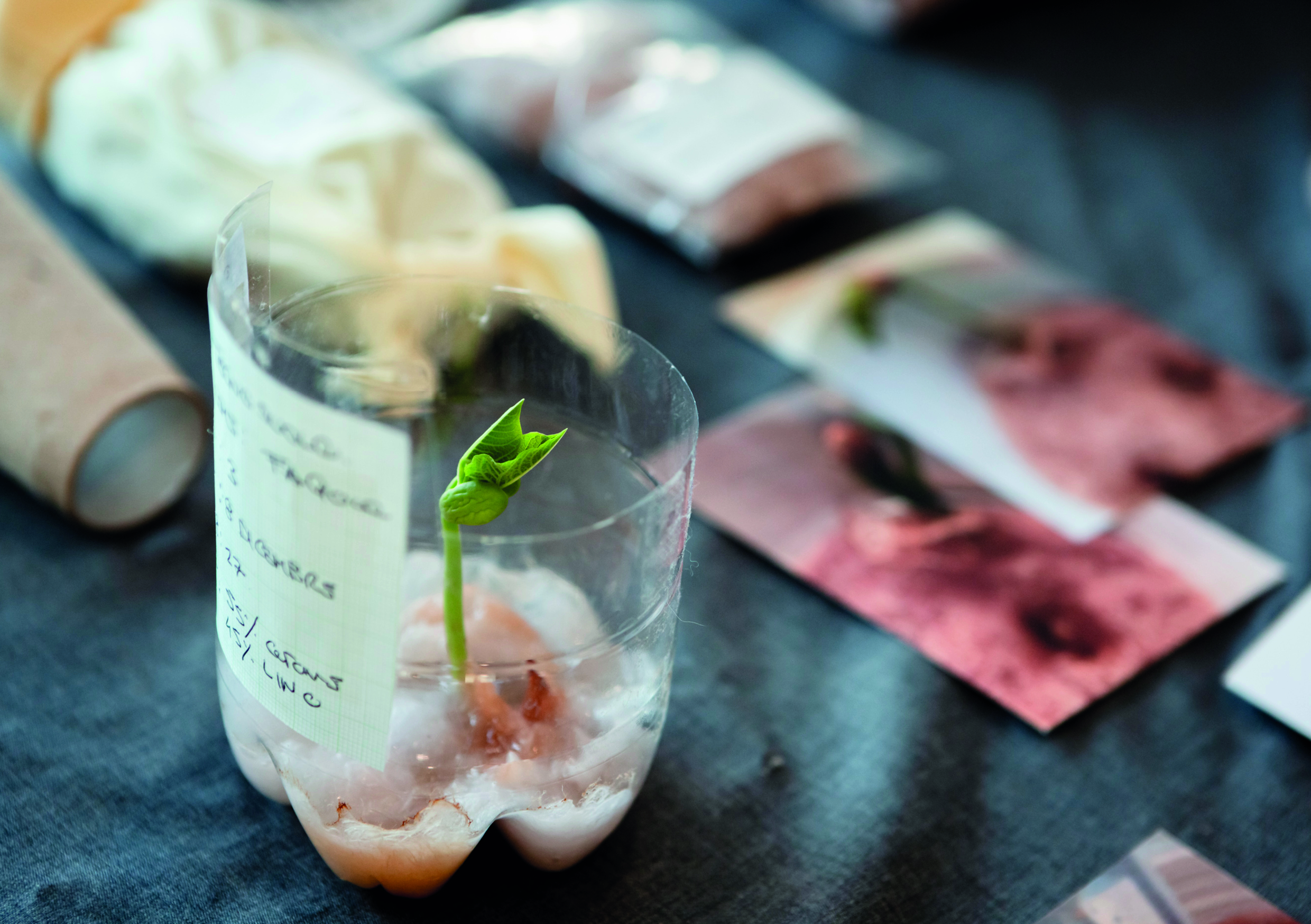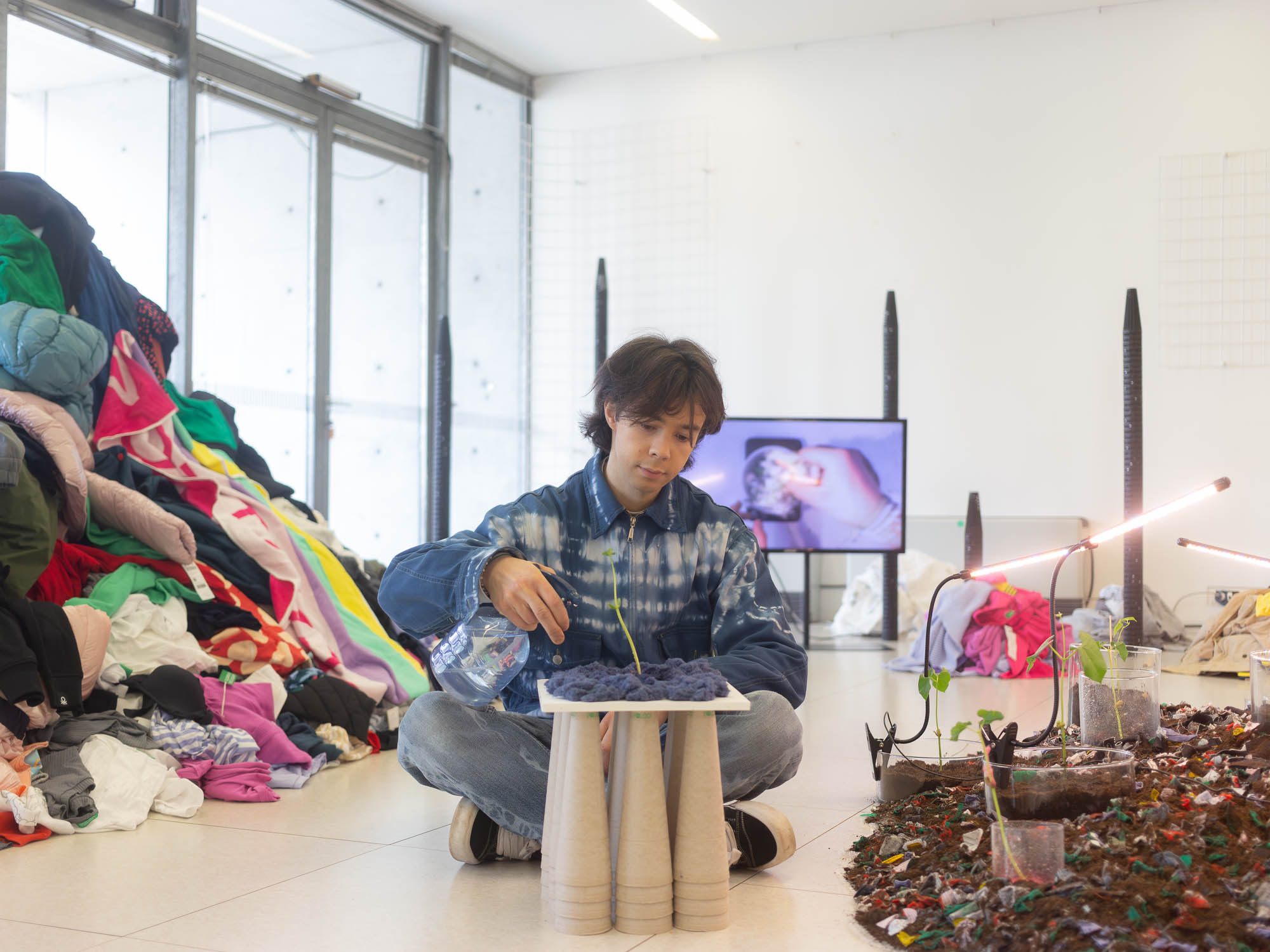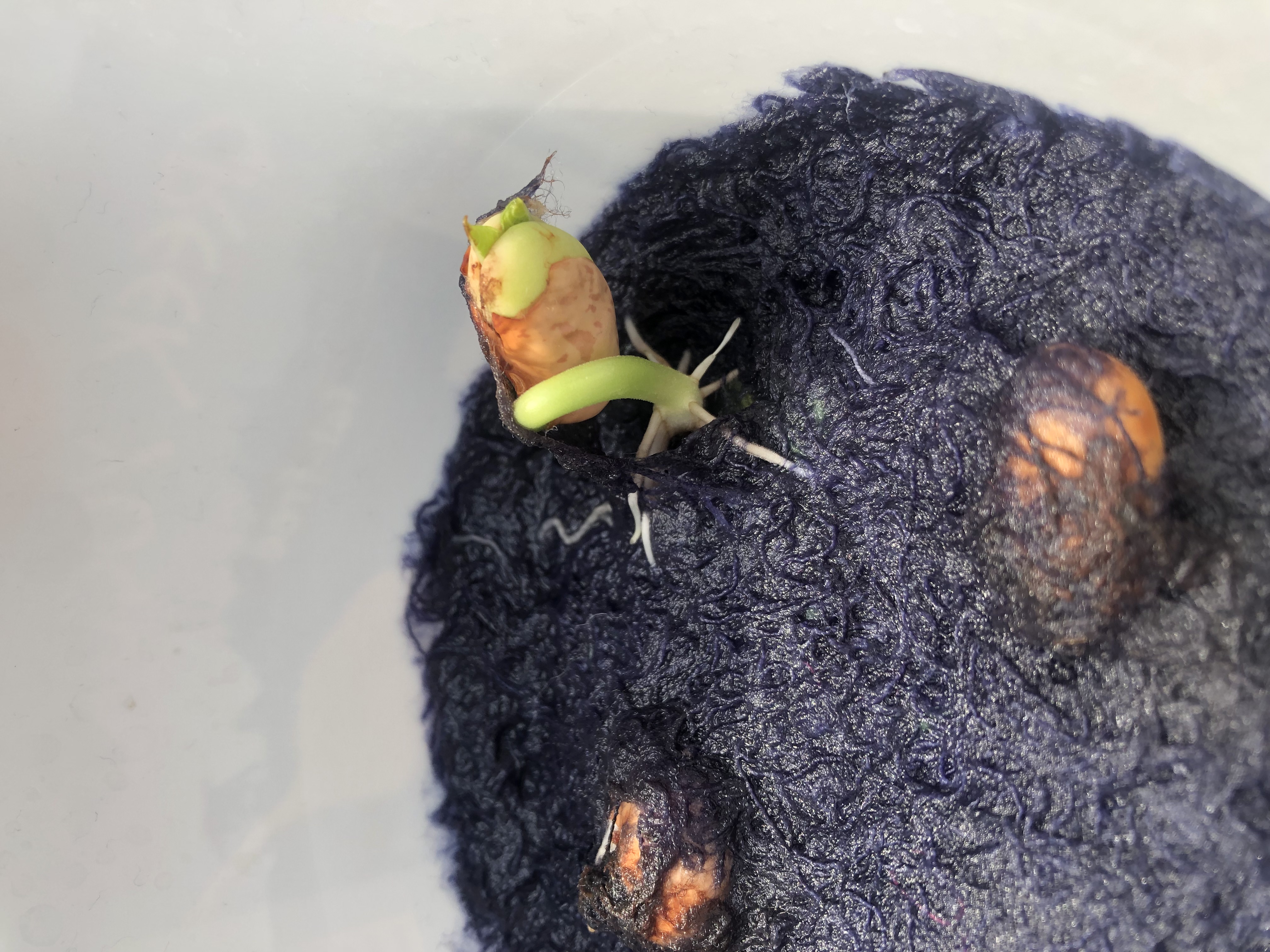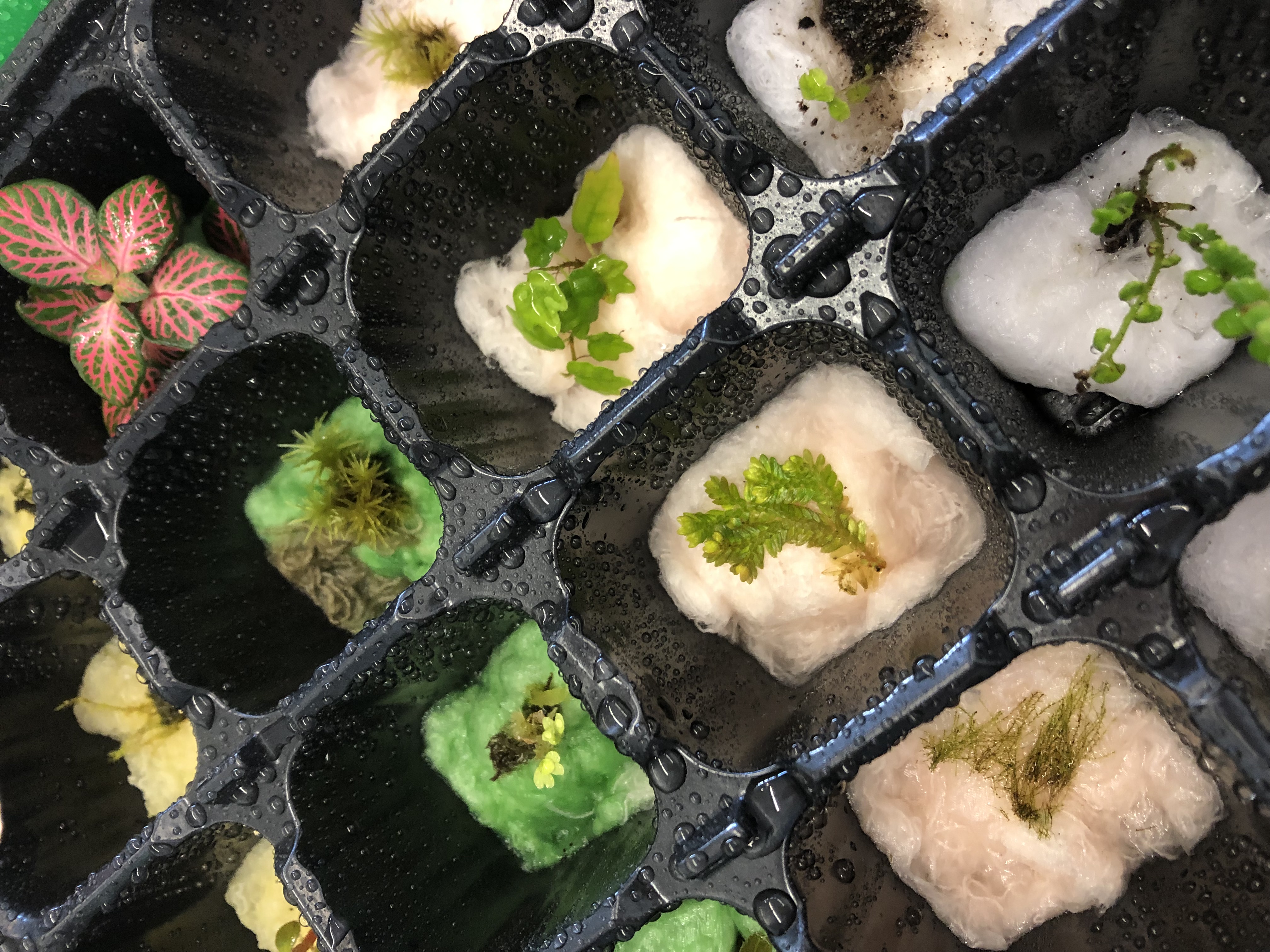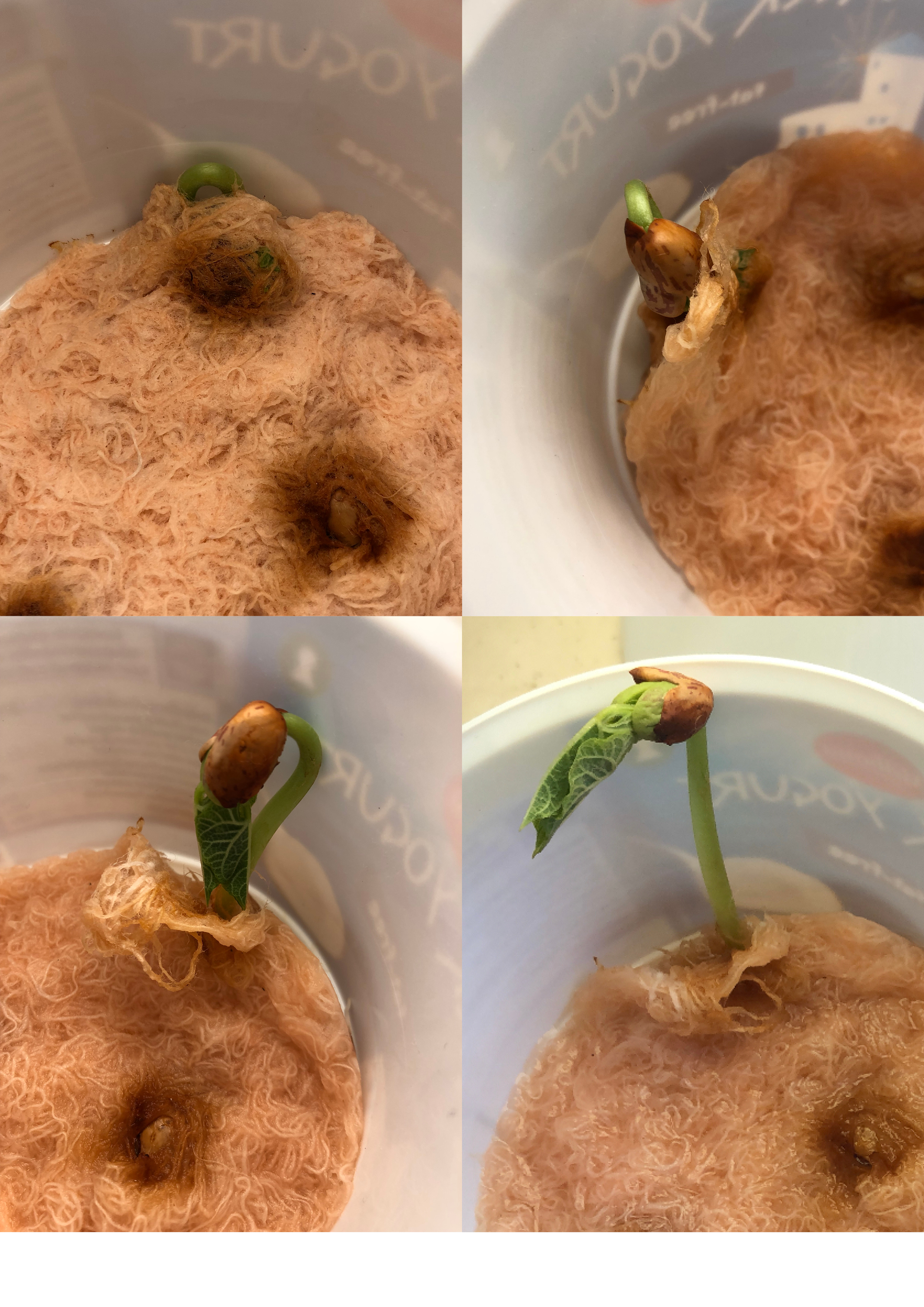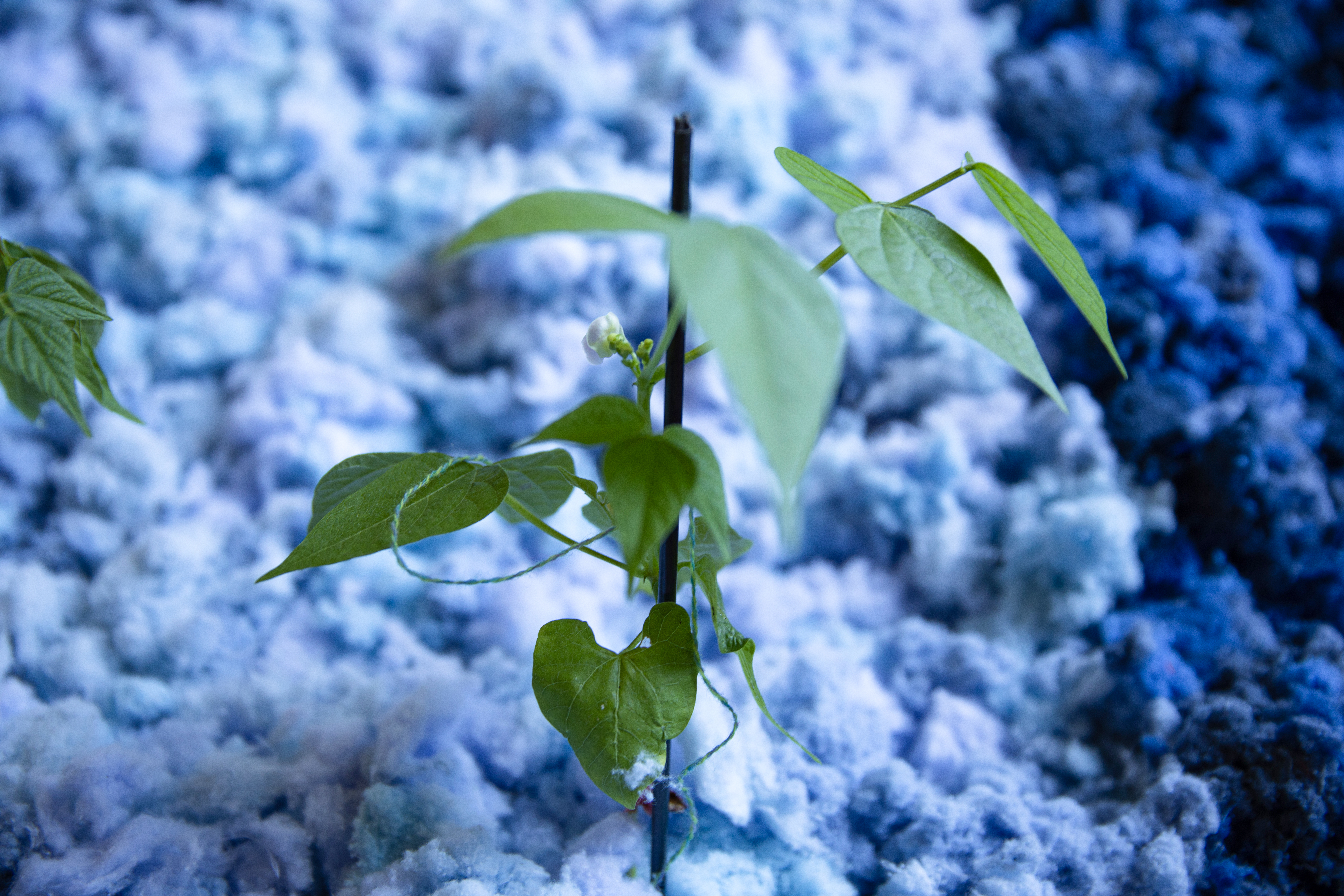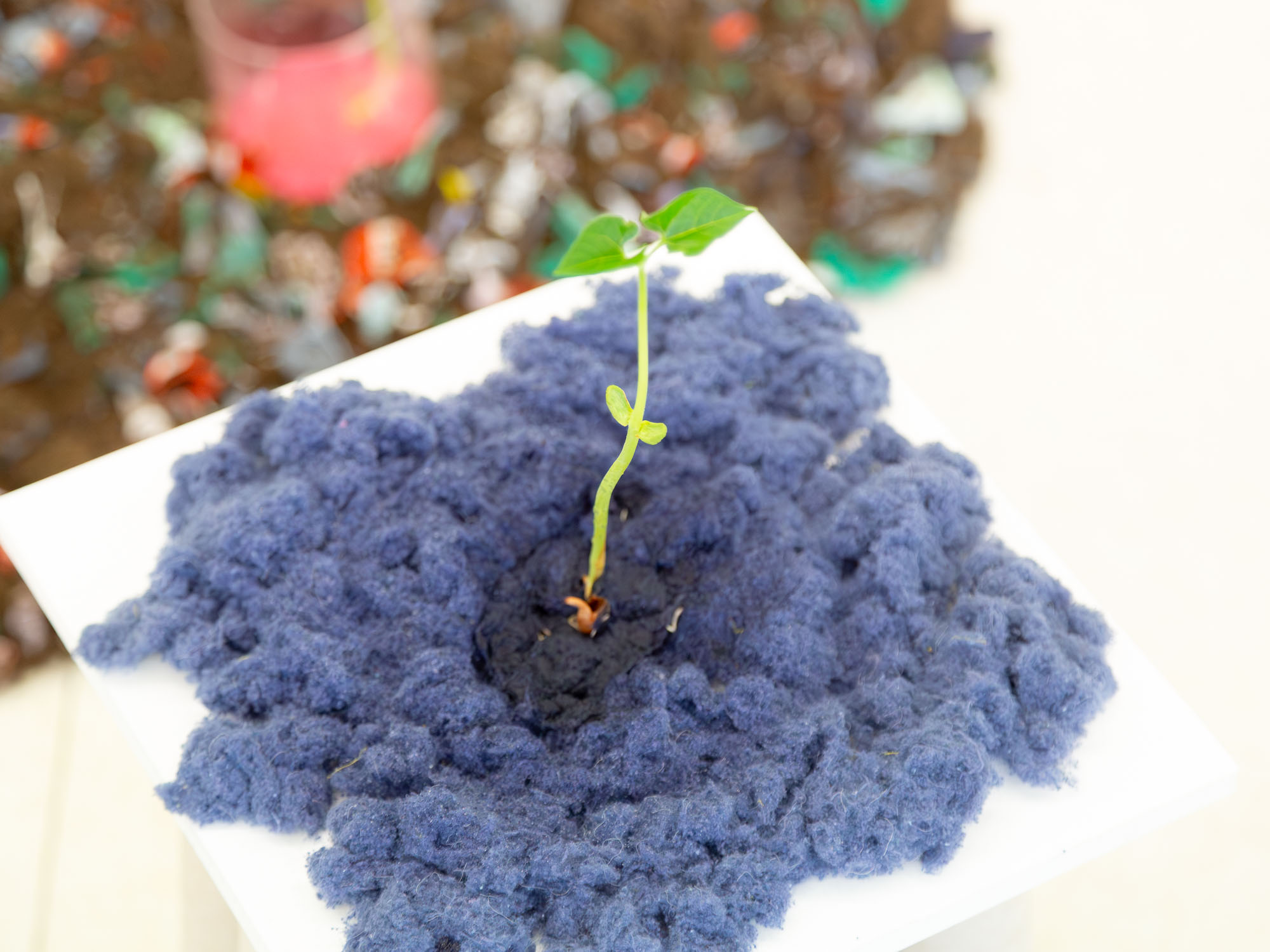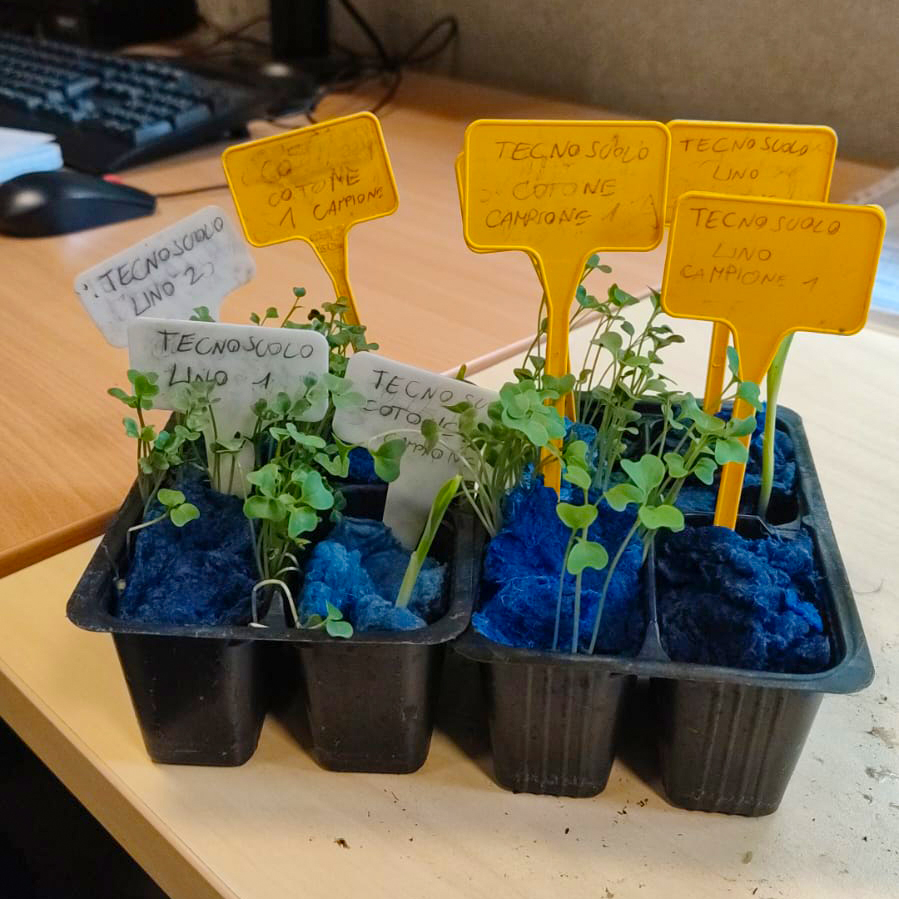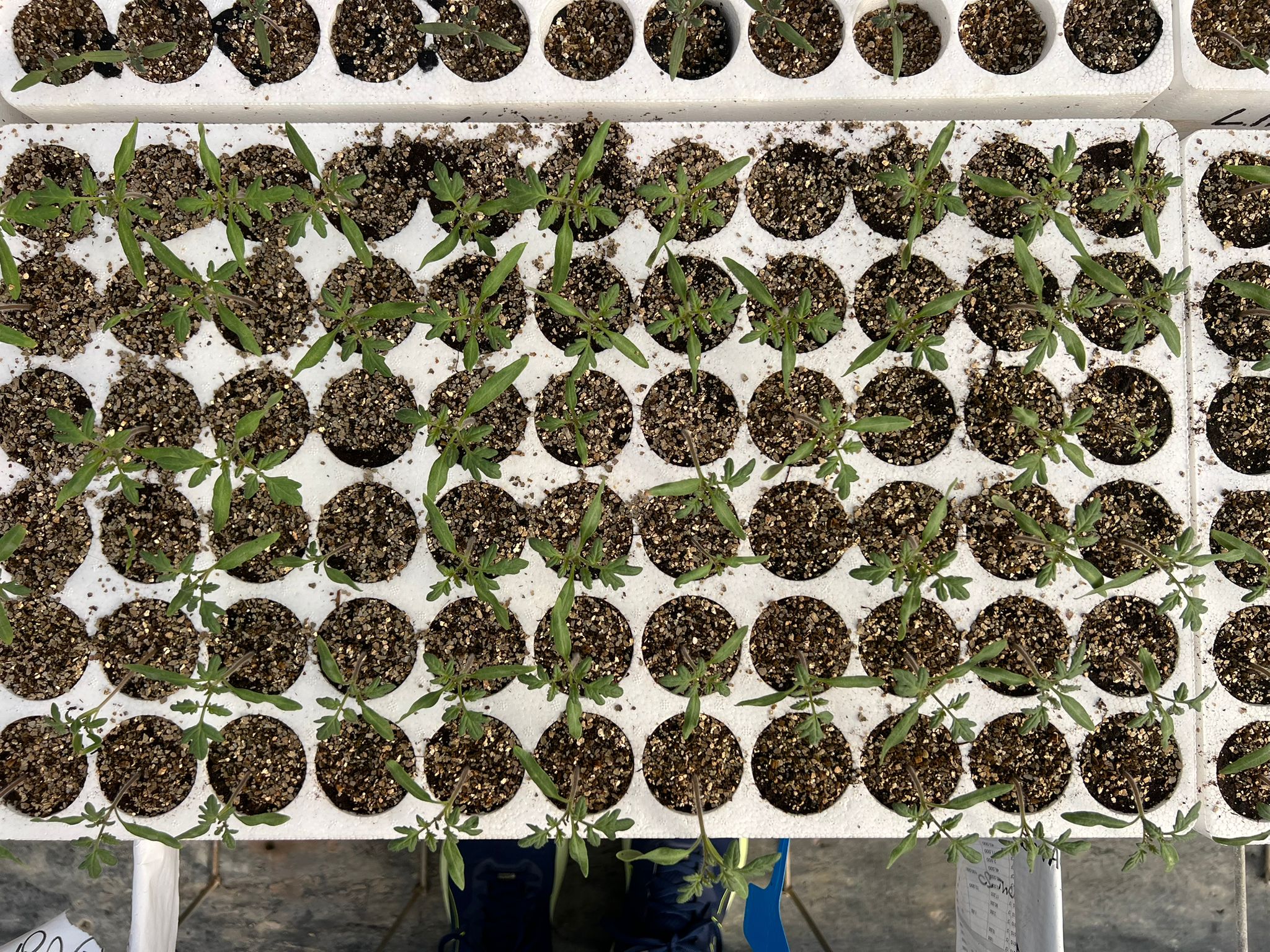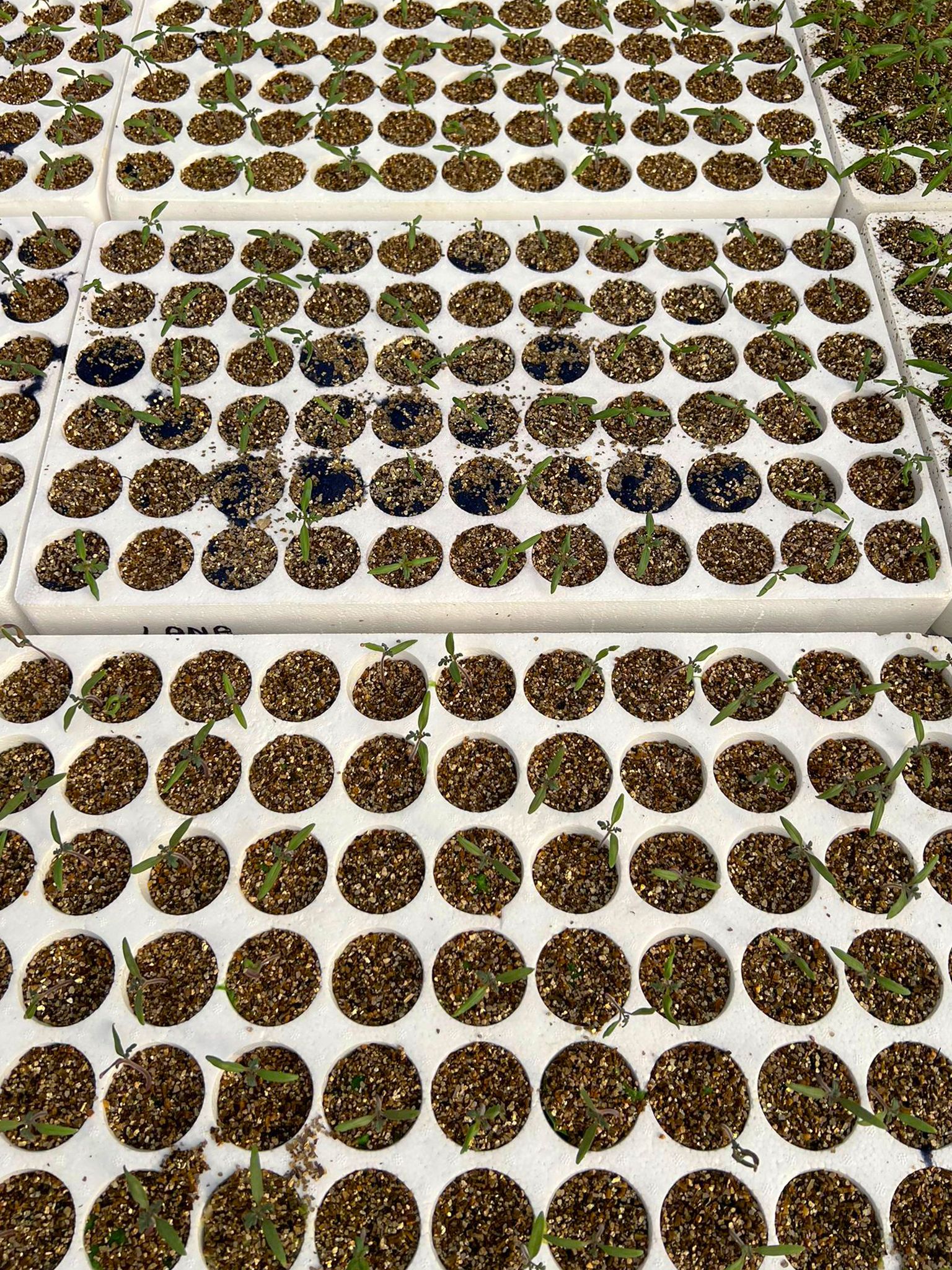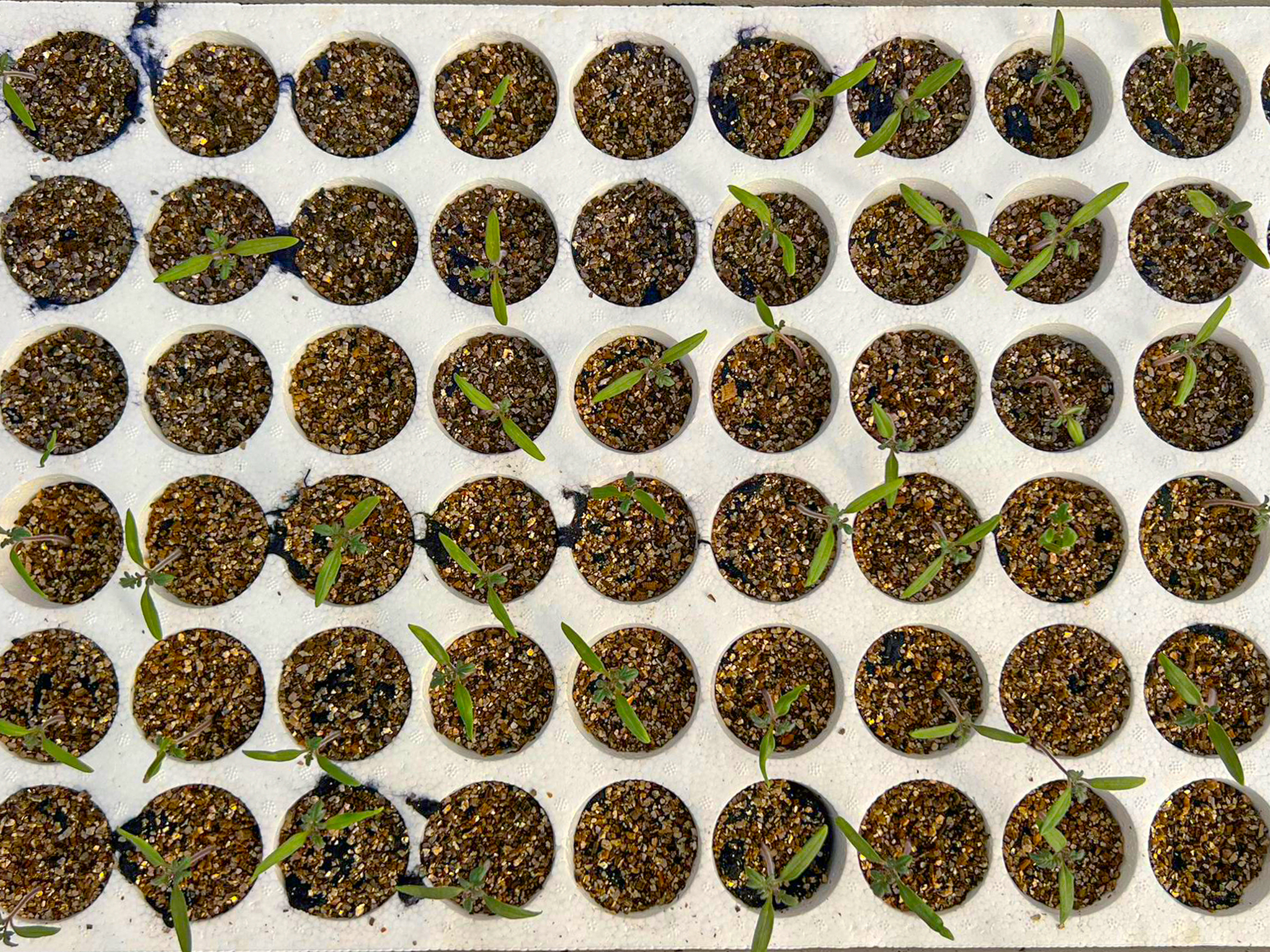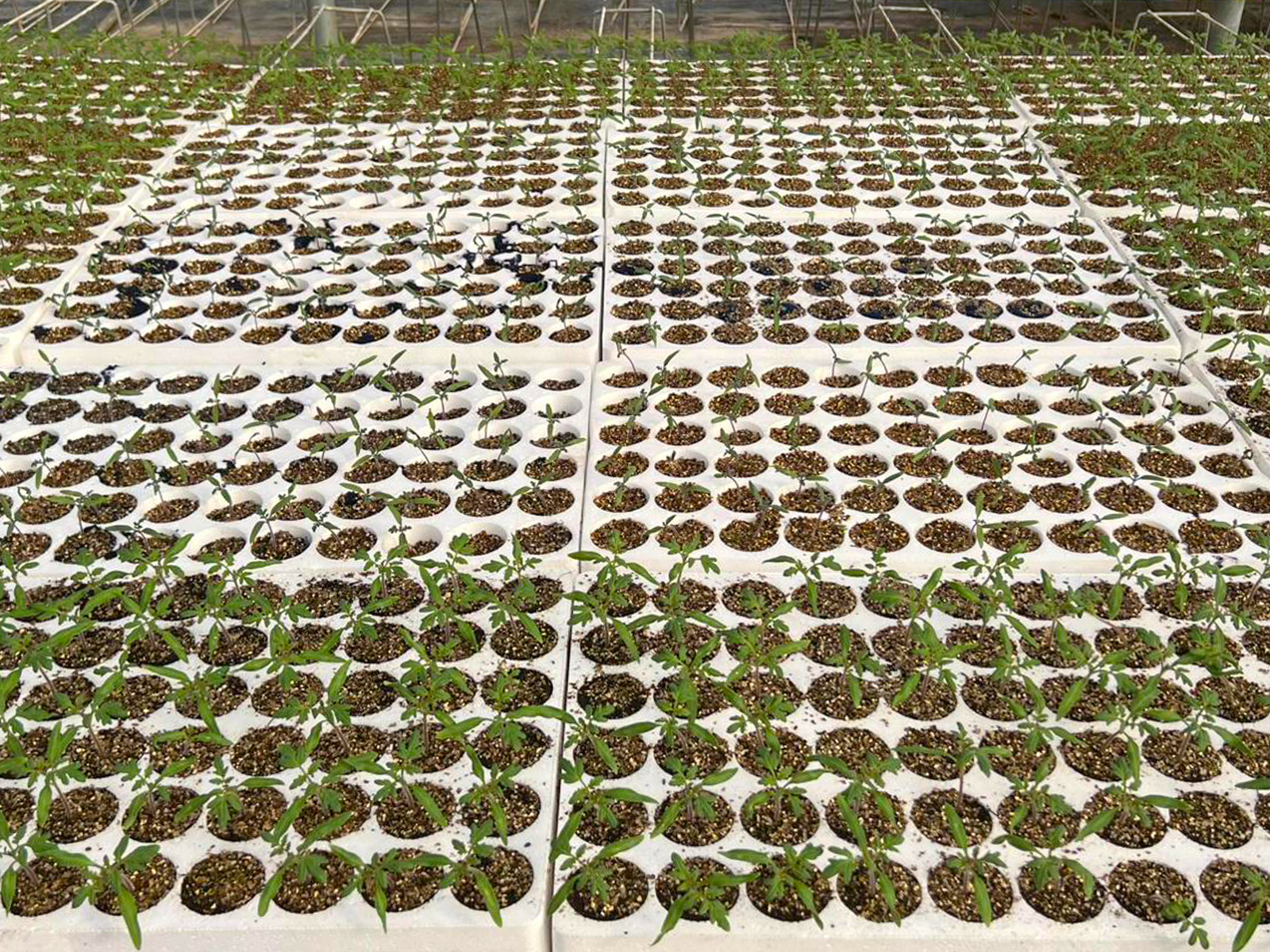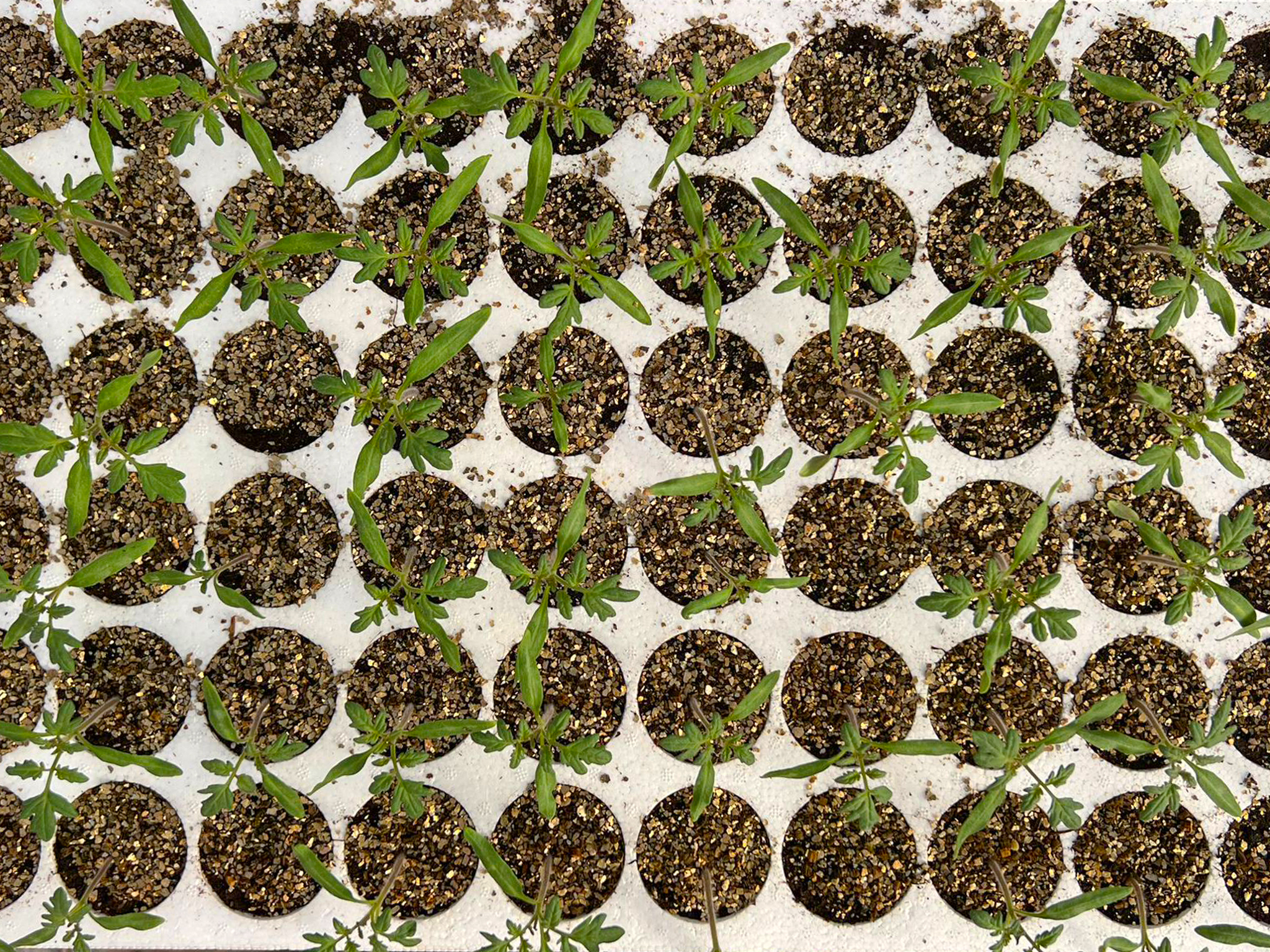Shaping a circular industrial ecosystem and supporting life-cycle thinking
Tecnosuolo
Tecnosuolo, the soil of the future
Tecnosuolo is the soil of the future, a research aimed at counteracting the impact of the textile industry on the environment and promoting the disposal of production waste in the place where they are produced. Through a sustainable approach, unsold clothing items made of fabrics of plant and animal origin are retransformed into textile fibers that become raw material to be used in the agricultural sector to develop new cultivation techniques that improve soil fertility and promote plant growth.
Italy
National
It addresses urban-rural linkages
It refers to a physical transformation of the built environment (hard investment)
Prototype level
No
No
As an individual
Tecnosuolo is a research aimed at countering the impact of the textile industry on the environment and promoting the disposal of production waste in the place where it is produced, which, to date, is instead packaged and shipped to non-European countries, where it becomes waste. Regenerating this waste, before it is exported, would contribute to improving the living conditions of the planet and reduce environmental pollution.
Through a sustainable approach, Tecnosuolo proposes a solution to improve the supply chain of the fashion world with the aim of giving value again to unsold and defective clothing items. These products are transformed with a grinding process, into textile fibers. A new raw material, extracted from waste, which is recontextualized in the agricultural sector and used to improve soil fertility and promote plant growth.
Tecnosuolo connects the textile industry with the agricultural sector, a system that is aimed at farmers, botanical gardens, greenhouses or nurseries, small agricultural entrepreneurs and Start-ups or SMEs that own hydroponic systems, to implement their cultivation techniques with the help of new sustainable materials. Organic textile fibers are used in agriculture as a replacement for natural resources, whose extraction has a high environmental impact by damaging natural ecosystems and are a sustainable alternative to products made with synthetic materials that pollute the soil with microplastics. Textile fibers are included in agricultural practices for the development of fertilizing substrates dedicated to plant germination and mulches to cover parts of the land. Tecnosuolo proposes a method of cultivation outside the soil that allows agricultural activity to develop and adapt to different places, becoming a social and inclusive practice that allows people to grow and produce their own food independently inside their homes. Tecnosuolo creates a network among citizens for the development of a new urban agricultural community.
Through a sustainable approach, Tecnosuolo proposes a solution to improve the supply chain of the fashion world with the aim of giving value again to unsold and defective clothing items. These products are transformed with a grinding process, into textile fibers. A new raw material, extracted from waste, which is recontextualized in the agricultural sector and used to improve soil fertility and promote plant growth.
Tecnosuolo connects the textile industry with the agricultural sector, a system that is aimed at farmers, botanical gardens, greenhouses or nurseries, small agricultural entrepreneurs and Start-ups or SMEs that own hydroponic systems, to implement their cultivation techniques with the help of new sustainable materials. Organic textile fibers are used in agriculture as a replacement for natural resources, whose extraction has a high environmental impact by damaging natural ecosystems and are a sustainable alternative to products made with synthetic materials that pollute the soil with microplastics. Textile fibers are included in agricultural practices for the development of fertilizing substrates dedicated to plant germination and mulches to cover parts of the land. Tecnosuolo proposes a method of cultivation outside the soil that allows agricultural activity to develop and adapt to different places, becoming a social and inclusive practice that allows people to grow and produce their own food independently inside their homes. Tecnosuolo creates a network among citizens for the development of a new urban agricultural community.
Industrial textile waste
Reuse and circularity
Sustainable disposal processes
Cultivation and agriculture
Agri-food production
Tecnosuolo invites textile companies to become aware of their production methods and disposal system, implementing changes within their supply chain and adopting ethical behaviors and circular practices. A system that criticizes overproduction and fast fashion and invites the end user to purchase ethically produced clothing, making them aware that their purchasing choice can have repercussions on society and the planet. Tecnosuolo rethinks the life cycle of the textile product by adopting a practice based on circularity to have no production waste. Once the product has fulfilled its function by reaching the end of its life, it is no longer conceived as a useless object but is valued for its material components. It is about analyzing the product as a material capable of being used for new purposes within a different economic system. Within the agricultural sector, the project thinks of an application that involves the use of textile fiber. New sustainable tools that will replace traditional products made of synthetic materials whose disposal has a high impact such as plastic mulching sheets and preserve the use of natural resources used in systems for the germination of crops such as peat. The extraction methods of this material are highly impactful and avoiding this process would mean preserving biodiversity and the functions of the natural ecosystem. The textile fiber has the ability to retain a lot of water, which means a great water saving and the possibility of growing and producing food even in periods of drought or in places where water is not available. The fertilizing substrate thinks of an autonomous cultivation system. Every citizen would have the opportunity to grow their own food at zero km, producing a correct quantity based on their needs, contributing to the reduction of waste. The method used by Tecnosuolo proposes local food production, based on a short-distance supply chain that would eliminate pollution due to the transport of food imports.
Through the application of Tecnosuolo textile fiber substrate, agriculture and food production enter the urban context and homes, becoming daily activities. Thinking about food with an autonomous and local production method would give people the opportunity to learn how to produce the food they consume. This gives a sense of responsibility to the citizen who must take care of and think about the growth of their crops. An approach that brings agriculture closer to people, making it a practice available to all. Tecnosuolo becomes a means to transfer knowledge and a need born in the rural context into the cities, becoming a new opportunity. People are introduced to the agricultural sector, learning how to cultivate and learn about the needs a plant requires to grow. An interactive and inclusive experience that introduces people to become aware and conscious of how food is produced. An opportunity to experience food not as a finished product, ready to be purchased, but as the fruit of dedication and care. Citizens will therefore be able to identify with the farmers of the future, experiencing first-hand all the processes needed to obtain food and grasp the importance of food production. Bringing cultivation into living spaces and cities means bringing the user closer to nature, harmonizing and personifying their space as a real greenhouse. A process that sees a return to nature in cities and in the daily lives of citizens. Homes become green spaces, environments that resemble natural contexts in which plants and humans live together, collaborating through a sustainable and innovative cultivation method. Plants contribute to creating healthy environments as they act as a filter that absorbs CO2 from the air, improving the liveability of interior spaces, making them healthier.
The project aims to solve the consequences of the inappropriate disposal methods of the textile industry. The disposal of textile waste occurs in non-European countries, which causes serious damage to the environment and damages the health of the inhabitants. The project takes into account this situation by preventing textile waste from becoming a harmful element, including in its solution a method that can restore the environment and the liveability of these countries. The project wants to eliminate the geographical disparities between industrialized countries and developing countries, reusing textile waste in the place where it is produced, to improve the cultivation techniques of the agricultural sector.
Tecnosuolo gives a way to experience agriculture as a daily activity, available not only to professionals in the sector, but also to the public and citizens. The cultivation tools designed by Tecnosuolo are low-cost as they are developed with an economical material extracted from production waste. The new cultivation techniques of the project have been tested through experiential and interactive activities open to the public in common and private spaces such as gardens and botanical gardens. Tecnosuolo transforms agriculture into a common practice to bring together people in a territory and create a local community. During experiential workshops, mulching activities and the creation of fertilizing substrate highlighted how agricultural practice could include people of different ages and backgrounds, generating a means to connect people working towards a common goal. The substrate is a tool that allows you to grow outside the soil. This allows you to develop your own crops and foods in different contexts, adapting to any type of soil. Agriculture is no longer an activity tied to the land and therefore to a particular specific geographical position, but becomes a versatile and inclusive practice.
Tecnosuolo gives a way to experience agriculture as a daily activity, available not only to professionals in the sector, but also to the public and citizens. The cultivation tools designed by Tecnosuolo are low-cost as they are developed with an economical material extracted from production waste. The new cultivation techniques of the project have been tested through experiential and interactive activities open to the public in common and private spaces such as gardens and botanical gardens. Tecnosuolo transforms agriculture into a common practice to bring together people in a territory and create a local community. During experiential workshops, mulching activities and the creation of fertilizing substrate highlighted how agricultural practice could include people of different ages and backgrounds, generating a means to connect people working towards a common goal. The substrate is a tool that allows you to grow outside the soil. This allows you to develop your own crops and foods in different contexts, adapting to any type of soil. Agriculture is no longer an activity tied to the land and therefore to a particular specific geographical position, but becomes a versatile and inclusive practice.
During the development of the project, participatory and interactive activities were included, such as workshops and laboratories. During these days of sharing the project, laboratories were held that experimented with the use of organic textile fiber to create a fertilizing substrate and to mulch parts of the soil. At the end of the laboratory activity, each participant was able to take with them their own container of substrate made with fibers, with the task of taking care of the germination of the seed and the growth of the plant. This step is a very important moment, because it increases the sense of responsibility, as the participants will have to take care of following and accompanying the growth of a living being. The workshop is not limited to a single day experience, but becomes a shared process, a social practice that can be replicated and scaled in different spaces and places. Workshops were structured by alternating practical and manual phases and sessions of reflection and project co-creation. Moments that have represented a means of communication to disseminate and make the project known to the public and raise awareness of certain issues, introducing them to new sustainable and multidisciplinary practices. A manual and interactive experience in which people have had the opportunity to personally experiment with the processes and implementation of Tecnosuolo. These experimental phases play a fundamental role in receiving immediate feedback on the project, transforming into co-design sessions, contributing to its growth and improvement. The laboratories have proven to be a solution to materialize the project in everyday reality. The research has had the opportunity and space to be applied as a new cultivation method within practical contexts such as greenhouses, vegetable gardens and gardens.
Tecnosuolo is a project created together with the Fabrica research center and supported by the Sustainability Department of Benetton Group. The company supported the initial phases of the project by providing waste material to work on. The collaboration with Benetton made it possible to think of an entrepreneurial project at a national and European level, implementing improvements in the company’s production chain and reorganizing the method of disposal of their waste. The project allowed the company to rework production waste for new applications, opening up to different markets that increased the company’s sustainable value. Having seen good results, the project began to dialogue with companies outside of Benetton. Collaborations with botanical gardens, greenhouses and nurseries such as the Aurelia Josz Botanical Museum owned by the municipality of Milan and the Tecnovivai of Ragusa, were a fundamental support for developing Tecnosuolo’s research in the agricultural sector. These entities experimented in their spaces and put into practice the cultivation techniques proposed by Tecnosuolo. A means to test the capacity of textile fiber as a germination substrate and mulch to obtain concrete results in the real context of use. The textile fertilizer substrate was applied inside the greenhouses of the Tecnovivai of Ragusa to replace peat as a seed germination cell while the mulch composed of wool textile fiber was used in the gardens of the Aurelia Josz Botanical Garden to replace plastic and coconut fiber mulching sheets. The project was exhibited at art galleries such as the Manuel Zoia Gallery and participated in design exhibitions, such as the Milan Design Week and Inverart. These experiences were a vehicle for communicating and disseminating the project that filtered the project in ways that were perceived and learned by the public. Interactive moments to meet potential buyers and end users of the project but also investors and new potential collaborators.
Tecnosuolo is a project built with a multidisciplinary method. Its development has connected different knowledge through the help of the skills of experts. The physics and chemistry departments of the universities were involved to analyze the components of the fibers and understand if they were suitable for use as a fertilizer for the soil and as a substrate for the growth of plants. Together we performed tests on the quality of the crops born from the textile substrate and the flavors and nutritional values of the foods generated by them. The chemistry laboratory spoke with the Benetton sustainability department to analyze the components of the clothing used in the project and check that they were not composed of toxic and harmful substances that would have had a polluting impact on the soil. After this comparison, it was decided to use only clothes belonging to a specific clothing line of the company called Green B, which does not use chemicals in it. The project used the expertise of agricultural sector bodies such as agronomists, botanists and nurserymen, describing guidelines such as light, period, geographical position, type of soil and nutrients to create the right context for the growth of certain crops. The expertise of the agricultural sector and the chemistry department came together to create specific substrates that had certain nutrients within them that were appropriate for promoting the growth of each type of plant. Once we learned which nutrients the plant required, and understood the fertilizing components of each plant and animal fiber, we could create a substrate for each specific crop. It was then decided to develop the project at an entrepreneurial level. The consultancy and funding of companies that deal with accelerating startups in the agri-food sector, with whom I am currently in dialogue, will serve to transform the project prototype into a marketable system that can be used by people in their everyday lives.
Using a hybrid approach, which combines hydroponic and traditional techniques, textile fibers of animal and plant origin are used as a plant substrate/fertilizer and as mulch.
The fertilizer substrate composed of fiber is used for the germination of seeds in the alveolus and for the growth of plants, reducing water consumption and promoting crop autonomy. The fabric has the ability to absorb and retain a greater quantity of water than soil, which allows plants to grow even in periods of drought or where water is not available. Furthermore, this agricultural system reduces the use of chemical fertilizers, since the roots of the plants absorb nutrients from the fibers of organic and biological fabrics (linen, wool, cotton)
In mulching, textile fibers are used to cover a part of the soil, giving it greater compactness and resistance to its structure, which allows plants to grow even in difficult conditions such as slopes or territories with strong morphological differences in level and to protect them from atmospheric phenomena. The fiber inside the soil creates voids that soften its structure, preventing the soil from compacting. In this way, air zones are created that allow the roots of the plants not to suffocate and spaces that allow them to grow in depth, absorbing a greater quantity of nutrients. Furthermore, the fiber insulates the soil from heat and excessive light, increasing its fertility and preserving the humidity and water inside it. The textile fiber can be placed around trees to protect them from damage caused by maintenance machinery and if used with a thickness greater than 10 cm, it suffocates weeds and useless plants, preventing their growth and safeguarding the health of the plant.
The fertilizer substrate composed of fiber is used for the germination of seeds in the alveolus and for the growth of plants, reducing water consumption and promoting crop autonomy. The fabric has the ability to absorb and retain a greater quantity of water than soil, which allows plants to grow even in periods of drought or where water is not available. Furthermore, this agricultural system reduces the use of chemical fertilizers, since the roots of the plants absorb nutrients from the fibers of organic and biological fabrics (linen, wool, cotton)
In mulching, textile fibers are used to cover a part of the soil, giving it greater compactness and resistance to its structure, which allows plants to grow even in difficult conditions such as slopes or territories with strong morphological differences in level and to protect them from atmospheric phenomena. The fiber inside the soil creates voids that soften its structure, preventing the soil from compacting. In this way, air zones are created that allow the roots of the plants not to suffocate and spaces that allow them to grow in depth, absorbing a greater quantity of nutrients. Furthermore, the fiber insulates the soil from heat and excessive light, increasing its fertility and preserving the humidity and water inside it. The textile fiber can be placed around trees to protect them from damage caused by maintenance machinery and if used with a thickness greater than 10 cm, it suffocates weeds and useless plants, preventing their growth and safeguarding the health of the plant.
The approach I used in this project reflects my studies based on social and product design. It is a multidisciplinary method in which different knowledge interact together to develop a project that can intervene on broader issues that aim to be included in environmental, social and economic debates to which design can contribute. A process that translates scientific and humanistic research into reality through the study of matter and the development of new materials made with new sustainable production processes. In the embryonic design phases I use an anthropological and archaeological investigation, with the aim of involving the local community and interacting with the materials produced by local activities. This phase of study of the territory develops through the development of new products and systems based on the use of local materials and the needs of the inhabitants. The analysis of the evolution of the Earth led me to become interested in the phenomenon of fossilization, in particular in the formation of a type of fossil called Technofossils. Technofossils are material waste of anthropocentric origin, residues of natural and artificial origin produced by the production processes of human activities. In the projects I act as an Archeodesigner, whose role is to reconstruct and describe history by digging through the rubble of the past and among the Technofossils, with which to create new materials or artifacts. In a circular and sustainable production system, the Archeodesigner rethinks the life cycle of the product by adopting a practice based on circularity to have no production waste. Once the product has fulfilled its function by reaching the end of its life, it is no longer conceived as a useless object but is reinterpreted as a material. The waste is reused by extracting its material components capable of being used for new purposes within different production processes and economic systems.
The process proposed by Tecnosuolo can be used and applied by entities in the textile sector that want to combat pollution due to the disposal of their excess production. The project valorizes defective and unsold clothing and fabrics through a mechanical defibration process that transforms the fabric into textile fiber. This method can be implemented with the help of industrial technologies consisting of machines with large rollers, belonging to some entities in the textile sector, capable of destroying the fabric and producing a large quantity of fibers. These means allow the project to be conceived on a large scale and to be replicated in various contexts, addressing in particular those who have a large quantity of waste. In the next phase of the project, Tecnosuolo proposes the reuse of textile fiber in the agricultural sector. Fiber is a versatile material that can adapt to different cultivation systems or tools based on their purposes. In particular, through the textile substrate, Tecnosuolo proposes an innovative and versatile method that allows the world of agriculture to break away from a specific cultivation territory, allowing cultivation outside the soil and the land based on one’s needs and habits. Agriculture is transformed into a practice in motion, adaptable, changeable and scalable in new and different contexts and places.
The Tecnosuolo learning method takes place through workshops based on experience and manual experimentation, which can be replicated in different public and private spaces, including targets of different ages. A teaching method in motion that adapts to the circumstances of each specific territory, developing local solutions. Tecnosuolo cultivation methods can be used in different ways by children, adults and the elderly. An inclusive project available to everyone that brings together and unites people at different distances.
The Tecnosuolo learning method takes place through workshops based on experience and manual experimentation, which can be replicated in different public and private spaces, including targets of different ages. A teaching method in motion that adapts to the circumstances of each specific territory, developing local solutions. Tecnosuolo cultivation methods can be used in different ways by children, adults and the elderly. An inclusive project available to everyone that brings together and unites people at different distances.
The project addresses global pollution due to the disposal processes of waste produced by the textile sector. Tecnosuolo reuses these residues, preventing them from being exported to non-European countries such as Kenya and Chile, where they are piled up in illegal open-air landfills and disposed of through fires that damage the environment and negatively impact the health of the inhabitants. Tecnosuolo connects the textile industry with the agricultural sector, reusing textile fiber locally for new cultivation systems. Within this research, my role as a designer is identified as a go-between that connects textile entities with other markets to give life to new collaborations, developed through sustainable processes. This step is essential to adopt a new system of disposal of textile waste, moving from a global polluting process to local reuse. Using these residues, before they are exported and become polluting material, as a textile fiber useful for germination substrates, would generate double sustainability. First of all, the raw material I use to make the substrate is not taken from nature, risking damaging its ecosystems, but I obtain it from an unused waste material. Secondly, by preventing this textile waste from being exported to other countries, safeguarding the pollution of the planet and people’s health. The textile substrate inserted in a residential and urban context thinks of a local food production system. The Substrate as a transportable object, would allow each individual to grow independently within their own living spaces. Food is no longer conceived as something foreign and is no longer imported, but is experienced as something territorial, consumed directly in the place of cultivation. The Tecnosuolo would give the possibility of developing small indoor farms within the urban context. The consumer will be able to request the type and quantity of food they want and collect it at the place of production within their own city.
The first topic that I will address in the subsequent phases of the project will certainly be the need to protect the idea of Tecnosuolo, relying on a patent office to stipulate a contract. The development of the project will continue with the search for new textile waste that can be reworked into a resource. A survey of textile companies that have a large amount of waste interested in using it in a sustainable way will follow. These textile companies represent not only a resource to obtain the raw material with which to realize the project, but also an opportunity for collaboration to obtain investments. Chemical tests will continue to verify that the components of the textile fibers used are not harmful in order to validate the project. Subsequently, a prototype of a fertilizing substrate obtained with organic textile fibers will be developed with which to experiment with plant growth. Consequently, analyses will be carried out to verify the quality of the crops obtained from the Tecnosuolo cultivation method and understand whether the foods generated by them have edible characteristics. At the same time, workshop sessions will be held on the project in collaboration with public and private companies in the agricultural sector that will serve to test the new cultivation tools in the application context and introduce and use them to new users. In this phase, the participant will be able to test the product first-hand and understand how it works. The laboratories represent a vehicle for receiving feedback on the project and improving it based on the consumer’s experience. We will continue with the implementation of the prototype, outlining a final product that can be marketed. Through the financial help of companies that deal with the acceleration of start-ups in the agri-food sector, Tecnosuolo will be able to evolve into a company to make a new product dedicated to cultivation available on the market. An online store dedicated to sales will therefore be created.

